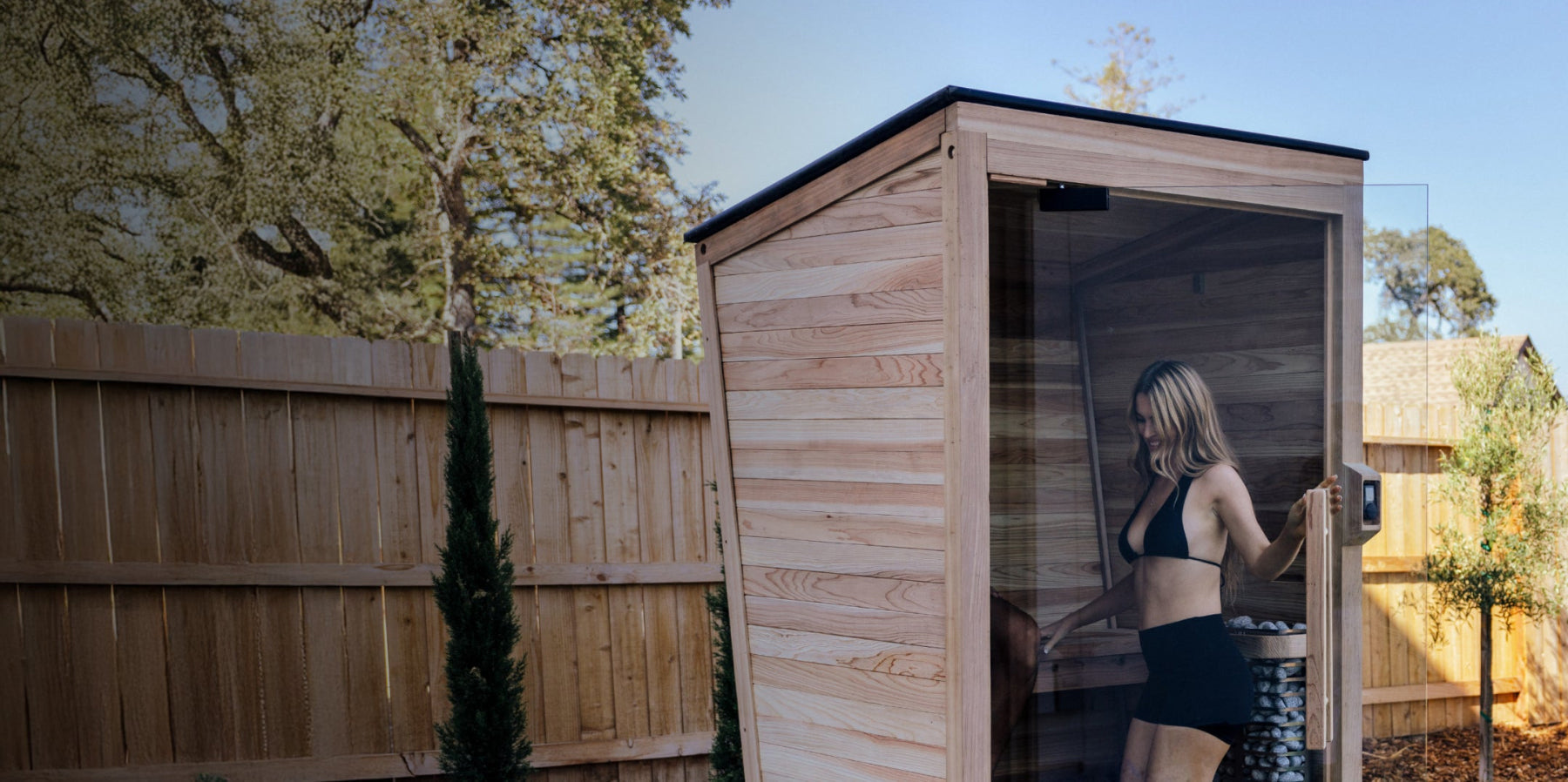
Cold Shower vs. Ice Bath: Which is Better?
Immersing yourself in cold water for therapeutic benefit is widely practiced today by athletes and others. If you don’t have your own ice bath, taking a cold shower after working out might be a familiar tactic. But does a cold shower really produce the same results? Here’s what you need to know:
Is a Cold Shower as Good as an Ice Bath?
An icy cold shower can feel really refreshing, but can it replace an ice bath and provide the same benefits? The short answer is no. This is because immersing yourself in a pool of icy cold water can lower your core body temperature more effectively and more quickly.
This is because the water coming from your tap is typically about 55 degrees Fahrenheit and it can dip to around 45 degrees Fahrenheit in colder months and climates. The water in a purpose-built cold plunge can reach as low as 39 degrees Fahrenheit. This provides the potential for added benefits over just having a cold bath from your tap or a cold shower. Put simply, ice baths and cold plunges are typically much more effective at their goal than a cold shower:
|
Cold Shower Benefits |
Ice Bath Benefits |
|
Can provide a boost of energy |
Can create a strong feeling of invigoration and euphoria after |
|
Slightly lowers body temperature |
Significantly (but safely) lowers body temperature |
|
Can improve stress levels |
|
|
Able to fully submerge your body |
|
|
Can improve immune system strength and stimulate vagus nerve |
|
|
Meditative and calming mindset |
|
|
and more |
Areas of Differentiation: Cold Shower vs. Ice Bath
While cold showers and ice baths might seem like they accomplish the same thing at a glance, there are important differences to understand between these two. These might be the difference between getting the results you want and not seeing much (if any) upside:
Temperature
As mentioned above, a big difference between cold showers and cold plunges is the temperature. While cold tap or shower water might be cold enough for beginners to start, the bulk of the benefits discussed really become evident as you work your way to colder temperatures. This makes a big difference in the results you see, as the impact that the cold has on your body will likely be much less pronounced at, say, 55°, compared to what you see with ice baths at 40°.
In addition to the absolute temperature having more capability in an ice bath, shower temperatures are notoriously hard to control (made more difficult by the water warming up as soon as it hits your skin). Cold plunges like the models we offer have precise temperature controls that stay where you want instead of slowly drifting hotter or colder the longer you spend in it.
Water Coverage
Not only are cold plunges colder than showers, but they’re also much more consistent in how they cover your body. A shower head limits the amount of direct and constant contact that the water, regardless of temperature, will make with your body. This makes it difficult to maintain a consistent cooling effect across your whole body, which you don’t have to worry about when submerged in a cold plunge. While many people cold plunge from the neck down, some go further with full submersion of their head to enhance some of the vasoconstriction benefits.
Safety
Each type of cold therapy can also have its own safety hazards. For example, when cold plunging, you should make sure that you have an anti-slip mat on the floor or are being careful not to slip and fall as you’re getting out. Safety in cold showers can come in a different form, as it might be dangerous for certain people to be standing upright on a slippery bathtub at the same time as experiencing a temperature shock. In these cases, laying or sitting in a cold plunge tub is a safer option.
Vagus Nerve Stimulation
Research has shown that cold temperatures can stimulate your vagal nerve, which helps control your heart, lungs, and digestive tract. Stimulating your vagus nerve has also been shown to help you relax and destress. While a cold shower could activate your vagus nerve, immersing your body in an ice bath is often more effective because you can more effectively cover your neck area and abdomen where this nerve extends.
Because an ice bath can also reach lower temperatures than a cold shower, it can potentially more rapidly and effectively activate this important nerve center. The result can be a fuller sense of relaxation and elimination of stress. While not as scientific, there is also plenty of anecdotal evidence that ice baths often feel more positive and invigorating (calm while in the water, sense of euphoria after getting out) than cold showers, which often feel difficult and uncomfortable.
Workout Recovery
What about for workout recovery? There’s no debating that a cold shower can feel cool and refreshing, but there is evidence that ice baths can provide more substantial (and longer-lasting) benefits. A study done in 2011 discovered that cyclists who underwent a rigorous training session had less soreness in their muscles after soaking in cold water for ten minutes. Another study done in 2016 found similar results. Cold water causes your blood vessels to constrict, reducing blood flow to the area that’s sore. This can temporarily reduce any inflammation. Many athletes swear by cold water immersion and ice baths after a workout to help with their recovery, in addition to getting enough fluids, stretching, rest, and healthy eating.
Fat Loss
Researchers are still looking into how weight loss might be related to exposure to cold temperatures, but things look promising. Studies have already shown that ice water immersion can speed up your metabolic rate, or the rate at which you burn calories. When you sit in ice water, your brown fat is activated to work harder at keeping you warm.
Other studies have shown that the more you expose yourself to cold temperatures, the better your brown fat becomes at doing its work when activated. In this way, soaking in ice water can spur your body to burn more calories.
We discuss the potential of cold plunging to help with weight loss more here.
Restful Sleep
As we mentioned above, an ice bath can help activate your vagus nerve for increased relaxation — and many who engage in cold plunging report better sleep. Athletes who find that an ice bath decreases their muscle soreness may also experience more restful and comfortable sleep.
Tying in with our discussion of recovery and soreness above, a solid night’s sleep has been shown to be essential to muscle recovery. While you sleep, your body is engaged in muscle recovery via protein synthesis and the release of human growth hormones. Not getting enough sleep or sleep deprivation over the long term has been linked to an increased chance of a variety of diseases. Anything that can help you get a good night’s sleep, including an ice bath, can potentially lead to better workout recovery and overall improved wellness.
Convenience & Cost
The final big differentiator between cold plunges and showers is the convenience and cost balance of each of them. From an initial glance, the cold shower might seem like it sweeps both categories here due to ice baths typically being limited to gyms and locker rooms — but a growing number of users are getting at-home cold plunge tubs that make them just as convenient as a shower. Not only that but financing options for these tubs make them more affordable than people might expect.
Cold Plunge vs. Cold Shower: Which is Right for You?
Cold therapy comes with many potential and known benefits when done right. Always consult with your doctor before beginning an ice bath routine, as it’s not for everyone, and in some people with certain health conditions, it can be dangerous.
For most people, however, cold plunging is generally safer and more effective than traditional cold showers. This often results in improved mental and physical health in a natural, relaxing environment that’s difficult to beat! Browse our selection of cold plunge tub options to find the right solution for you, or get started with our new generation of All-In tubs today.






















